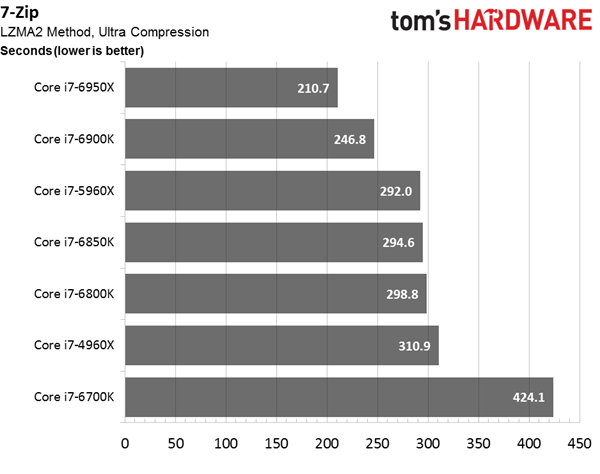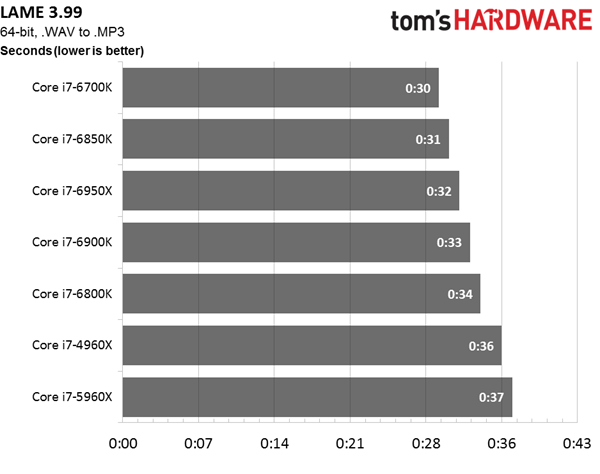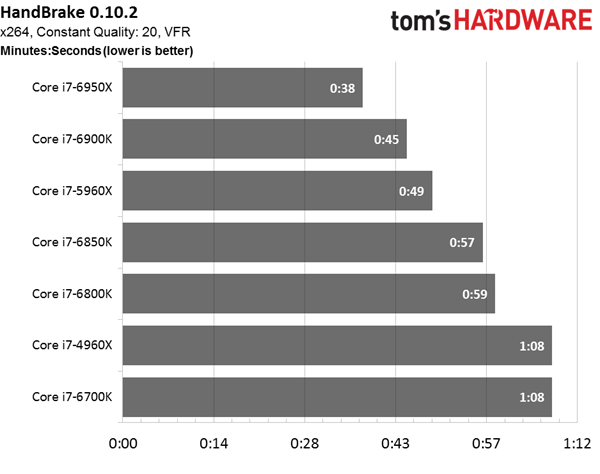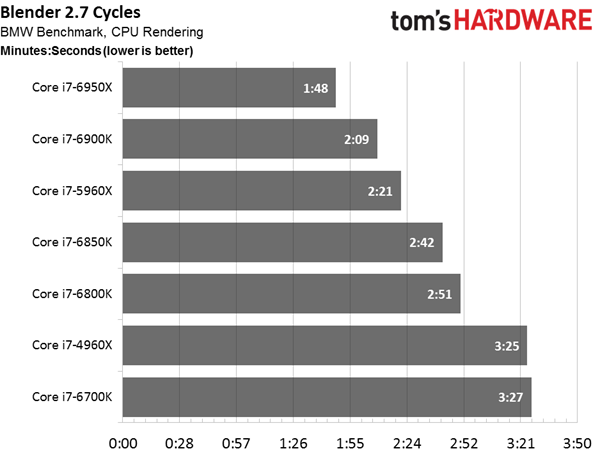Broadwell-E: Intel Core i7-6950X, 6900K, 6850K & 6800K Review
Is Broadwell more attractive to enthusiasts without graphics and up to 10 Hyper-Threaded cores? We test against two previous generations, plus Skylake to find out.
Desktop Productivity Results
7-Zip
The results you get from 7-Zip vary wildly depending on the options you use. For instance, when we compress an archive using LZMA, Intel’s Core i7-6700K actually beats the 10-core -6950X. Granted, the test takes more than 17 minutes to finish. Switching to LZMA2 enables the numbers in this chart, cutting our first-place finisher down to three and a half minutes. Although Intel’s Core i7-6700K now lands in last place, its result is just over seven minutes.
In short, pay attention to the way you’re using compression software. 7-Zip is very powerful (and free), but you’ll want to experiment a bit to get the best balance between file size, speed and your particular PC.
LAME
LAME is a single-threaded MP3 encoder we like to use to explore single-threaded performance. That helps explain why Core i7-6700K and its 4.2GHz peak Turbo Boost frequency lands in first place. The -6850K, rated for up to 3.8GHz in lightly-threaded workloads, finishes in second, followed by the flagship -6950X. We would have expected the Core i7-6900K in third, given its higher peak clock rate. However, it does trail closely in fourth place.
Notably, we monitored LAME while it was running to see if Turbo Boost Max Technology 3.0 pushed any of the Broadwell-E CPUs beyond their rated Turbo Boost 2.0 clock rates, but we never saw frequencies break past those specified ceilings.
HandBrake
This open source video transcoder is well-equipped to utilize available host processing resources. Intel’s Core i7-6950X easily snags a first-place finish, followed by both eight-core models. Three six-core CPUs take the next spots in exactly the order we’d expect. Finally, despite its modern four-core architecture and blazing 4GHz base clock rate, the Core i7-6700K only manages to tie the two-generation-old -4960X.
Blender
Blender is an open source 3D content creation suite with support for modeling, rigging, animation, simulation, rendering, compositing and motion tracking. It’s hardly surprising that the 3D pipeline lends itself to parallelization, giving Intel’s 10-core Broadwell-E flagship another easy win. The -6900K finishes our BMW render benchmark in second place, followed by the other eight-core CPU in our chart, the -5960X. Two Broadwell-E-based six-core processors take the next pair of spots, while a six-core Ivy Bridge-E model surfaces second to last. The Skylake-based Core i7-6700K only wields four cores, but an IPC throughput advantages and 4GHz base clock rate help make up some of the core count deficit. It loses to the -4960X by just two seconds.
Cinebench
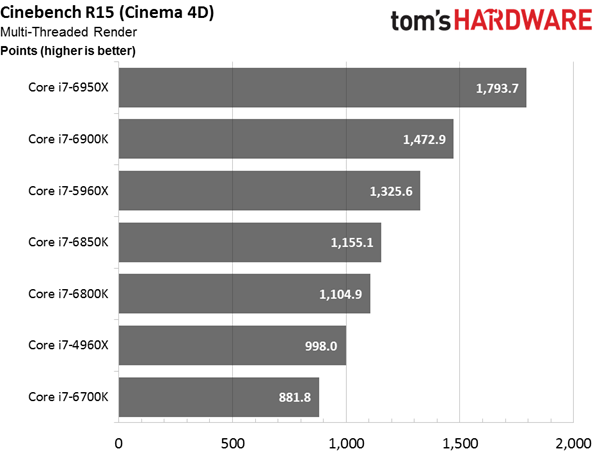
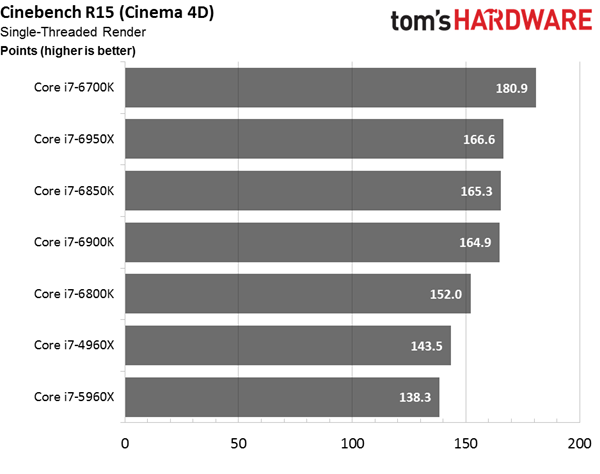
The -6700K’s standing in these next two charts illustrates the importance of picking the right processor for the applications you run. In the same piece of software, Skylake either finishes in first or last place.
Get Tom's Hardware's best news and in-depth reviews, straight to your inbox.
Naturally, once we start looking at the threaded numbers, Intel’s new Core i7-6950X shoots to the top. But between its Broadwell architecture and modest Turbo Boost clock rate, it only falls halfway down the chart when we switch back to single-threaded mode. The -6900 and -6850 also do a solid job of maintaining their positions in the field, regardless of workload.
MORE: Best CPUs
MORE: All CPU Content
MORE: Intel & AMD Processor Hierarchy
Current page: Desktop Productivity Results
Prev Page Game Results Next Page Adobe Creative Suite Results-
jt AJ was expecting a bit more info and review usage of turbo 3.0. also looks like most of broadwell E chip is junk.. except that one 6850k chip you received probably lucky 1.25v for 4.4v would be good thats only because its broadwell. got one here for 4.8ghz at just 1.22v.Reply -
Nuckles_56 Chris, how likely is it that a noctua NH-D15 would be able to cool these heat producing monsters if your h100i struggled and failed with the i7-6800k @4.4GHz.Reply
But a truly excellent review, even if it does show that there is little reason to go to broadwell-E over Haswell-E -
elho_cid I'd love to step up to the realm of higher core count, but given the results of Adobe SW when scaling to many threads, meas it is not really useful right now. :/Reply
That's a pity, because the most time I spend staring at a progress bar is when I'm using Adobe products. I don't really need more power to "background tasks" like zipping or lame encoding.
-
AdmiralDonut Standard SLI is not limited on the new NVIDIA cards. The only thing that's limited is the new High Bandwidth SLI. Normal 3 and 4-way SLI can be enabled easily by simply asking NVIDIA for an unlock code, something any half way serious enthusiast will most certainly do. Here's some more info on this matter:Reply
https://www.youtube.com/watch?v=2wBDt9tN5-c -
bit_user I don't really see the point of having a $1700 non-Xeon SKU. Of the few people who can afford it, even less would bother/dare to overclock it.Reply
I'm still wishing for the rumored 5 GHz SKU to surface. I've rarely needed more than 4 cores, but a couple extra GHz always comes in handy. Even so, I'll not be upgrading until at least Skylake-E or perhaps Kaby-E.
-
Cerunnir ReplyChris, how likely is it that a noctua NH-D15 would be able to cool these heat producing monsters if your h100i struggled and failed with the i7-6800k @4.4GHz.
But a truly excellent review, even if it does show that there is little reason to go to broadwell-E over Haswell-E
NH-D15 is arguably better or atleast equal to the H100i when it comes to cooling, and its noise levels is definatly lower both in load and while idle.
http://www.relaxedtech.com/reviews/noctua/nh-d15-versus-closed-loop-liquid-coolers/2 -
bit_user Reply
No. Buy a Xeon version, for that. It's practically the only difference. It's artificial product differentiation, known as "market segmentation".18045773 said:Does it have support for ECC ram?
Here, you can find links to the specs of the CPUs mentioned in this article: http://ark.intel.com/products/family/79318/Intel-High-End-Desktop-Processors#@Desktop If you view their individual specs, you can see that none support ECC.
Intel hasn't yet announced the E5-16xx v4 series CPUs, but you can turn up leaked specs with a bit of searching.
And you'll need motherboard support, too.
-
cats_Paw Good review (excellent if its only the heads up for a more in-depth one).Reply
I have to say that I would love to have a 6 or even 8 core CPU but these prices and performances dont add up.
In my country a 6700K and a 5820K are priced almost the same, but its still a hard choice (Do i want a "maybe" future proof 6 core that can be good for some work or a 4 core that is flat out faster and cheaper to build around for gaming?). -
pyoverdin Am I correct in saying I could build a PC that's 5 FPS off the 6950X for it's price?Reply
